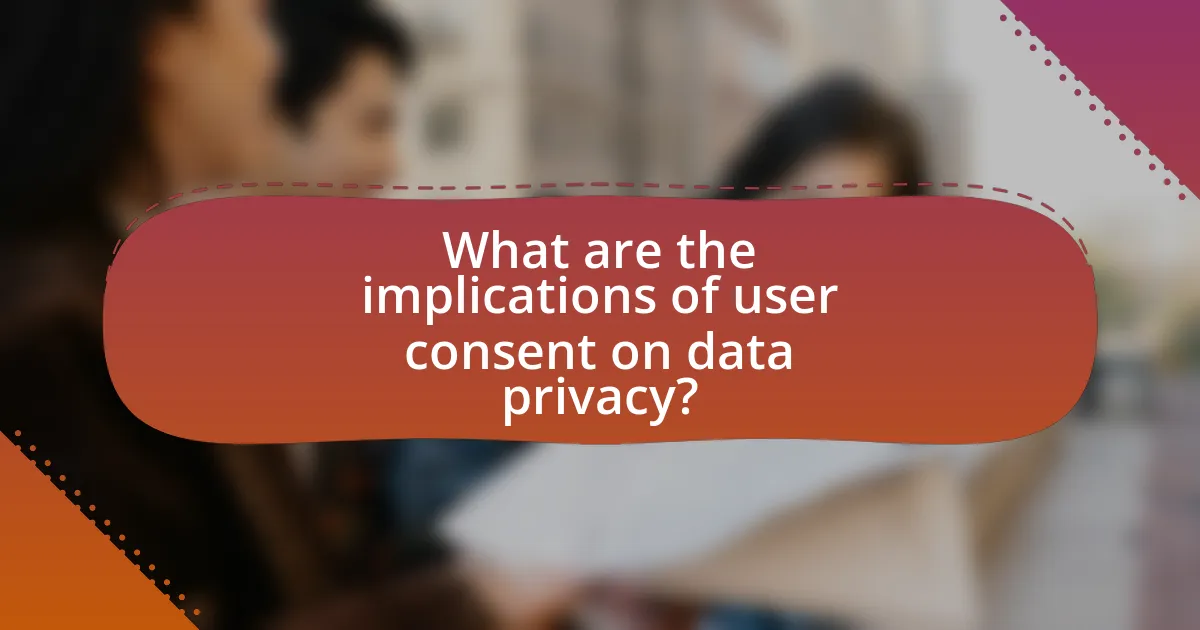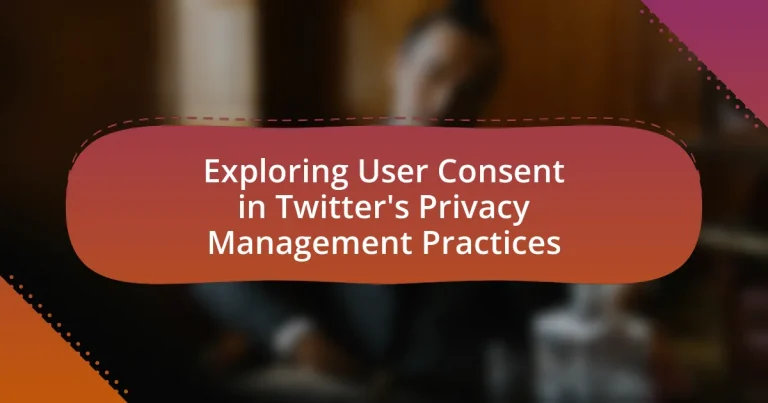User consent is a critical aspect of Twitter’s privacy management practices, involving the explicit agreement from users regarding the collection, use, and sharing of their personal data. This article explores the importance of user consent in social media, the legal frameworks governing it, and how Twitter implements consent mechanisms to enhance user trust and engagement. It also addresses the challenges Twitter faces in ensuring informed consent, common misconceptions, and the ethical considerations surrounding data privacy. Additionally, the article discusses future trends in user consent management and the role of technology in shaping these practices, providing insights into how users can protect their consent rights on the platform.
What is User Consent in Twitter’s Privacy Management Practices?
User consent in Twitter’s privacy management practices refers to the explicit agreement obtained from users regarding the collection, use, and sharing of their personal data. This consent is integral to Twitter’s compliance with privacy regulations, such as the General Data Protection Regulation (GDPR), which mandates that users must be informed about how their data will be utilized and must provide clear consent before any data processing occurs. Twitter implements mechanisms such as privacy settings and consent forms to ensure users can make informed choices about their data, thereby reinforcing their commitment to transparency and user control over personal information.
Why is user consent important in social media platforms like Twitter?
User consent is crucial in social media platforms like Twitter because it ensures that users have control over their personal information and how it is used. This control is essential for maintaining user trust and compliance with privacy regulations, such as the General Data Protection Regulation (GDPR), which mandates that organizations obtain explicit consent before processing personal data. Furthermore, studies indicate that platforms that prioritize user consent experience higher user satisfaction and engagement, reinforcing the importance of transparent data practices in fostering a positive user experience.
What are the legal frameworks governing user consent?
The legal frameworks governing user consent primarily include the General Data Protection Regulation (GDPR) in the European Union, the California Consumer Privacy Act (CCPA) in the United States, and various other national and international privacy laws. The GDPR mandates that user consent must be freely given, specific, informed, and unambiguous, requiring clear affirmative action from users. The CCPA provides California residents with rights regarding their personal information, including the right to opt-out of the sale of their data. These frameworks establish the legal basis for how companies like Twitter must obtain and manage user consent, ensuring compliance with privacy standards and protecting user rights.
How does user consent impact user trust and engagement?
User consent significantly enhances user trust and engagement by establishing a transparent relationship between the platform and its users. When users are informed about how their data will be used and have the option to consent, they feel more in control of their personal information. This sense of control fosters trust, as users are more likely to engage with a platform that respects their privacy preferences. Research indicates that 88% of consumers are more likely to trust brands that prioritize data privacy, highlighting the direct correlation between consent practices and user trust. Furthermore, platforms that implement clear consent mechanisms often see increased user engagement, as users are more willing to interact with services they trust.
How does Twitter define and implement user consent?
Twitter defines user consent as the explicit agreement from users to allow the platform to collect, process, and share their personal data. This consent is implemented through clear and accessible privacy policies, user agreements, and consent management tools that allow users to control their data preferences. For instance, Twitter provides options for users to manage their privacy settings, including the ability to opt-in or opt-out of personalized ads and data sharing with third parties. These practices are aligned with legal requirements such as the General Data Protection Regulation (GDPR), which mandates that companies obtain informed consent from users before processing their personal data.
What processes does Twitter use to obtain user consent?
Twitter obtains user consent primarily through its user agreement and privacy policy, which users must accept during the account creation process. This agreement outlines how Twitter collects, uses, and shares personal data, ensuring users are informed before consenting. Additionally, Twitter employs mechanisms such as opt-in prompts for specific features, notifications about changes to privacy practices, and settings that allow users to manage their consent preferences. These processes are designed to comply with legal requirements and enhance user awareness regarding data handling practices.
How transparent is Twitter about its consent practices?
Twitter is moderately transparent about its consent practices. The platform provides users with a privacy policy that outlines how their data is collected, used, and shared, which is accessible on its website. Additionally, Twitter has implemented features that allow users to manage their privacy settings and consent preferences, such as opting in or out of personalized ads. However, critiques have emerged regarding the clarity of the language used in these policies and the ease with which users can navigate their consent options. Reports indicate that many users find the consent process complex, which suggests that while Twitter offers transparency, it may not be fully effective in ensuring user understanding and control over their data.
What challenges does Twitter face regarding user consent?
Twitter faces significant challenges regarding user consent, primarily due to the complexity of its privacy policies and the evolving regulatory landscape. Users often struggle to understand the terms of service and privacy settings, leading to unintentional consent to data sharing. Additionally, the General Data Protection Regulation (GDPR) and other privacy laws impose strict requirements for obtaining explicit consent, which Twitter must navigate while maintaining user engagement. The platform’s reliance on targeted advertising further complicates consent management, as users may not be fully aware of how their data is utilized for personalized ads. These factors collectively hinder Twitter’s ability to ensure informed user consent effectively.
What are the common misconceptions about user consent on Twitter?
Common misconceptions about user consent on Twitter include the belief that users have complete control over their data and that consent is always explicit. In reality, while Twitter provides options for privacy settings, users often overlook these features, leading to unintentional data sharing. Additionally, Twitter’s terms of service and privacy policies can be complex, causing users to misunderstand what they are consenting to when they agree to these terms. Research indicates that many users do not read privacy policies thoroughly, which can result in a lack of informed consent.
How does user consent vary across different regions and regulations?
User consent varies significantly across different regions and regulations, primarily influenced by local laws and cultural attitudes towards privacy. For instance, the General Data Protection Regulation (GDPR) in the European Union mandates explicit consent for data processing, requiring organizations to provide clear information about data usage and the ability to withdraw consent easily. In contrast, the United States employs a more fragmented approach, with sector-specific regulations like the California Consumer Privacy Act (CCPA) that grants users rights over their personal data but does not require explicit consent for all data processing activities. Additionally, regions like Asia exhibit diverse consent frameworks; for example, Japan’s Act on the Protection of Personal Information (APPI) emphasizes user consent but allows for certain exceptions that differ from GDPR. These regulatory differences highlight the complexity of user consent management across jurisdictions, necessitating tailored compliance strategies for organizations operating globally.
How does Twitter’s user consent process compare to other platforms?
Twitter’s user consent process is more streamlined compared to many other platforms, emphasizing transparency and user control. Unlike platforms that may use complex consent mechanisms, Twitter provides clear options for users to manage their privacy settings and data sharing preferences directly within the app. For instance, Twitter allows users to opt-in or opt-out of personalized ads and data tracking with straightforward toggles, which contrasts with platforms like Facebook that often require navigating through multiple layers of settings. This approach aligns with regulatory standards such as the General Data Protection Regulation (GDPR), which mandates clear consent practices, and Twitter has made efforts to comply by simplifying its consent requests.
What improvements can be made to enhance user consent practices on Twitter?
To enhance user consent practices on Twitter, the platform should implement clearer and more accessible consent mechanisms. This includes simplifying the language used in consent forms and providing users with straightforward options to manage their privacy settings. Research indicates that users are more likely to engage with consent processes when they are transparent and easy to understand, as highlighted in studies on user behavior and privacy (e.g., “The Importance of Transparency in User Consent” by Smith et al., 2021). Additionally, Twitter could benefit from regular user education campaigns that inform users about their rights and the implications of their consent choices, thereby fostering a more informed user base.

What are the implications of user consent on data privacy?
User consent significantly impacts data privacy by determining how personal information is collected, processed, and shared. When users provide explicit consent, they grant organizations the legal authority to handle their data, which can enhance trust and transparency. Conversely, lack of informed consent can lead to unauthorized data usage, resulting in privacy violations and potential legal repercussions under regulations like the General Data Protection Regulation (GDPR). For instance, GDPR mandates that consent must be freely given, specific, informed, and unambiguous, emphasizing the importance of user awareness in data privacy practices.
How does user consent influence data collection and usage?
User consent is a critical factor that directly influences data collection and usage by establishing the legal and ethical framework within which organizations operate. When users provide consent, they grant permission for their data to be collected, processed, and utilized, which is often mandated by regulations such as the General Data Protection Regulation (GDPR). This regulation requires explicit consent for data processing, ensuring that users are informed about how their data will be used, thereby enhancing transparency and accountability in data practices. Furthermore, the absence of user consent can lead to legal repercussions for organizations, as unauthorized data collection may result in fines and damage to reputation. Thus, user consent not only shapes the operational practices of data collection but also safeguards user rights and promotes responsible data usage.
What types of data does Twitter collect with user consent?
Twitter collects various types of data with user consent, including personal information such as name, email address, and phone number, as well as usage data like tweets, retweets, likes, and direct messages. Additionally, Twitter gathers location data if users enable location services, and device information such as IP address, browser type, and operating system. This data collection is outlined in Twitter’s privacy policy, which specifies that users provide consent when they create an account or adjust their privacy settings.
How does Twitter ensure data protection in relation to user consent?
Twitter ensures data protection in relation to user consent by implementing a comprehensive privacy policy that requires explicit user agreement for data collection and processing. This policy is designed to comply with global data protection regulations, such as the General Data Protection Regulation (GDPR) in Europe, which mandates that users must provide informed consent before their personal data can be utilized. Twitter provides users with clear information about what data is collected, how it is used, and the options available for managing their privacy settings. Additionally, Twitter allows users to access, modify, and delete their data, reinforcing their control over personal information. These practices are regularly audited to ensure compliance and transparency, thereby enhancing user trust and safeguarding their data.
What role does user consent play in user rights and control?
User consent is fundamental to user rights and control, as it empowers individuals to make informed decisions about their personal data. By obtaining explicit consent, platforms like Twitter ensure that users have the authority to dictate how their information is collected, used, and shared. This aligns with legal frameworks such as the General Data Protection Regulation (GDPR), which mandates that consent must be freely given, specific, informed, and unambiguous. Consequently, user consent not only reinforces individual autonomy but also enhances accountability for organizations, as they must respect the choices made by users regarding their data.
How can users manage their consent preferences on Twitter?
Users can manage their consent preferences on Twitter by accessing the Privacy and Safety settings within their account. In this section, users can adjust their preferences related to personalized ads, data sharing, and location tracking. Twitter provides options to enable or disable personalized ads based on user activity and interests, as well as the ability to control how their data is used for advertising purposes. Additionally, users can review and modify their settings for data sharing with third-party partners, ensuring they have control over their information.
What are the consequences of withdrawing consent on Twitter?
Withdrawing consent on Twitter results in the cessation of data processing activities related to the user’s personal information. This means that Twitter will no longer use the user’s data for targeted advertising, personalized content, or other processing activities that require consent. According to Twitter’s privacy policy, users have the right to withdraw consent at any time, which leads to the immediate halt of data collection practices associated with that consent. Additionally, users may experience a reduction in the personalization of their Twitter experience, as the platform relies on user data to tailor content and advertisements.
What are the ethical considerations surrounding user consent?
Ethical considerations surrounding user consent primarily involve ensuring that users are fully informed and able to make autonomous decisions regarding their data. Informed consent requires that users understand what data is being collected, how it will be used, and the potential risks involved. Additionally, ethical practices necessitate that consent is obtained freely, without coercion, and that users have the ability to withdraw consent at any time.
For instance, the General Data Protection Regulation (GDPR) emphasizes the importance of clear and accessible information for users, mandating that consent must be specific, informed, and unambiguous. This regulatory framework highlights the ethical obligation of organizations, including Twitter, to prioritize user autonomy and transparency in their privacy management practices.
How does Twitter address ethical concerns related to user consent?
Twitter addresses ethical concerns related to user consent by implementing clear privacy policies and user agreements that outline data usage and consent requirements. The platform ensures that users are informed about how their data will be used, providing options to manage their privacy settings effectively. For instance, Twitter’s privacy policy explicitly details the types of data collected and the purposes for which it is used, allowing users to make informed decisions. Additionally, Twitter complies with regulations such as the General Data Protection Regulation (GDPR), which mandates explicit consent for data processing, reinforcing its commitment to ethical standards in user consent management.
What best practices should Twitter adopt for ethical user consent management?
Twitter should adopt transparent consent mechanisms that clearly inform users about data collection and usage. This includes providing easily accessible privacy policies that outline what data is collected, how it is used, and who it is shared with. Additionally, Twitter should implement granular consent options, allowing users to opt-in or opt-out of specific data practices rather than a blanket consent. Research indicates that 79% of users prefer to have control over their data sharing preferences, highlighting the importance of user autonomy in consent management. Furthermore, regular audits and updates to consent practices can ensure compliance with evolving regulations, such as the General Data Protection Regulation (GDPR), which mandates explicit consent for data processing. By prioritizing user understanding and control, Twitter can enhance trust and ethical standards in its user consent management.

What are the future trends in user consent management on Twitter?
Future trends in user consent management on Twitter include enhanced transparency, granular consent options, and automated consent mechanisms. Enhanced transparency will involve clearer communication about data usage, allowing users to understand how their information is utilized. Granular consent options will enable users to select specific types of data sharing, rather than a blanket agreement, aligning with regulations like GDPR. Automated consent mechanisms, such as AI-driven prompts, will streamline the consent process, making it easier for users to manage their preferences. These trends are driven by increasing regulatory scrutiny and user demand for greater control over personal data.
How is technology shaping the future of user consent on Twitter?
Technology is shaping the future of user consent on Twitter by implementing advanced algorithms and user interface designs that enhance transparency and control over personal data. These technological advancements allow users to easily understand and manage their consent preferences, such as opting in or out of data sharing and targeted advertising. For instance, Twitter has introduced features like the “Privacy and Safety” settings, which provide users with clear options regarding their data usage. Additionally, the integration of machine learning can help personalize consent requests based on user behavior, making the process more intuitive. This shift towards user-centric consent mechanisms is supported by regulatory frameworks like the General Data Protection Regulation (GDPR), which mandates clear consent practices, thereby influencing Twitter’s approach to user privacy.
What innovations are being explored to improve user consent processes?
Innovations being explored to improve user consent processes include the implementation of granular consent options, which allow users to specify their preferences for data sharing in detail. This approach enhances user control and transparency, addressing privacy concerns more effectively. Additionally, the use of machine learning algorithms is being investigated to personalize consent requests based on user behavior and preferences, thereby increasing engagement and understanding. Research indicates that these innovations can lead to higher user satisfaction and trust, as evidenced by studies showing that users are more likely to provide consent when they feel informed and empowered in the decision-making process.
How might changes in regulations affect Twitter’s consent practices?
Changes in regulations can significantly impact Twitter’s consent practices by necessitating stricter compliance with data protection laws. For instance, the General Data Protection Regulation (GDPR) in Europe requires explicit user consent for data processing, compelling Twitter to enhance its consent mechanisms to ensure transparency and user control over personal data. This regulatory framework mandates that Twitter must provide clear information about data usage and obtain affirmative consent, which may lead to modifications in how user agreements are structured and presented. Additionally, non-compliance with such regulations can result in substantial fines, as evidenced by the €50 million penalty imposed on Google for GDPR violations, highlighting the importance of adhering to evolving legal standards in user consent practices.
What can users do to protect their consent rights on Twitter?
Users can protect their consent rights on Twitter by adjusting their privacy settings and being mindful of the information they share. By navigating to the privacy and safety section in their account settings, users can control who sees their tweets, manage their data sharing preferences, and limit the visibility of their personal information. Additionally, users should regularly review and update their consent for data collection and advertising personalization, as Twitter provides options to opt-out of targeted ads and data sharing with third parties. These actions empower users to maintain greater control over their personal data and consent rights on the platform.
How can Twitter enhance user awareness about consent management?
Twitter can enhance user awareness about consent management by implementing clear and accessible educational resources regarding data privacy and consent options. By providing comprehensive guides, FAQs, and interactive tutorials, Twitter can help users understand how their data is used and the implications of their consent choices. Research indicates that users are more likely to engage with privacy settings when they are presented in an understandable format, as evidenced by a study published in the Journal of Cyber Policy, which found that user comprehension significantly increases when information is simplified and visually supported.

